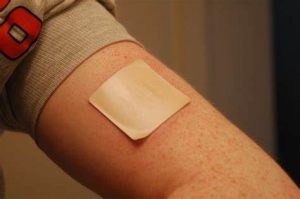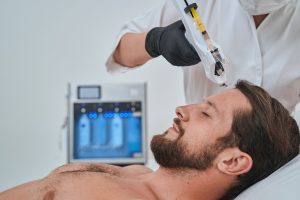Testosterone replacement therapy, also called androgen replacement therapy, is a medical procedure that replaces the lack of testosterone in the body with a higher concentration of the hormone. The therapy is often prescribed to treat male hypogonadism.

It is important to be aware that testosterone injections can pose risks.
There are several forms of this therapy, including injections, Transdermal patches, and subcutaneous testosterone pellets. However, it’s important to know that there are some serious side effects associated with these treatments.
Injection therapy
If you have low testosterone levels, testosterone injections may be the solution. Your doctor will be able to diagnose the problem and discuss the treatment options with you. You should also be aware of any risks associated with testosterone injections. Some of these risks include an increase in sleep apnea and fluid retention. You should also be sure to keep yourself healthy by exercising regularly and avoiding smoking.
This treatment is very effective and involves a series of injections into the patient’s muscles. The injections are usually given once a month. The doctor will prescribe an anti-androgen tablet to help reduce the risks associated with the treatment.
Testosterone levels decline naturally in older men, but low testosterone can be a sign of a more serious condition. Hypogonadism, a disorder of the testicles and pituitary gland, is a common cause of low testosterone. In addition, injuries to the testicles, cancer treatments, malnutrition, and stress can all cause lower levels of testosterone. Consequently, many doctors do not prescribe testosterone unless there are other symptoms.
Men with breast cancer or prostate cancer should not use this treatment. It contains testosterone undecanoate, refined castor oil, and benzyl benzoate. Despite these risks, the FDA has approved this testosterone preparation. However, the FDA announced last month that it is investigating cardiovascular safety data on testosterone preparations.

Although there’s been known risk, new research has shown that testosterone therapy can increase bone mass and decrease anemia.
There are some risk associated with testosterone therapy, however, recent studies have shown that testosterone therapy has the potential to increase bone density and lower anemia. Some postmenopausal women may even benefit from this therapy. For women, however, there is little clinical evidence that testosterone treatment improves libido.
There are two types of testosterone injections: testosterone enanthate and testosterone cypionate. Testosterone enanthate has a half-life of eight to ten days, while testosterone cypionate has a half-life of about 12 days. However, it may vary from person to person.
Men must be aware that side effects from testosterone therapy can persist for many months or even years. Some men experience mild side effects while others experience none at all.
Transdermal patches
Transdermal patches for testosterone replacement therapy are a convenient way to replace lost or depleted levels of testosterone in the body. These patches are applied to the skin on a regular schedule, usually at the same time every evening. To ensure that the patches work properly, use the patches as prescribed and do not expose the patch to moisture or heat. To prevent irritation, apply a hydrocortisone cream to the skin after application. Afterwards, it is best to wait at least three to four hours before applying the next patch.

The effects of these patches vary, so it is important that you select the right product for you.
There are several different types of testosterone patches available. These patches differ in their amounts and effects, so it is important to choose the right product for your needs and follow the manufacturer’s instructions for use. The patches should be applied to clean, dry skin, and not on areas with a history of rashes, infections, or other medical conditions. The patches should also not be applied to the scrotum or any bony area.
A common side effect of testosterone transdermal patches is skin rashes, which may be associated with redness and itchiness. These symptoms are often due to improper placement or an allergic reaction to the patches’ synthetic materials. If you’re experiencing these side effects, you should seek medical advice and consult with a doctor before continuing to use this product.
Transdermal patches should not be applied to the buttocks or scrotum, where the patches may be difficult to adhere. Moreover, the patches also should not be applied to areas where you have a lot of hair. Furthermore, you should rotate the application site every day.
After applying the testosterone transdermal patches, make sure you keep them in a safe place. You don’t want to lose one or worse, the entire set. This can happen accidentally, so it’s important to keep track of the patch you’re using. Once you’ve applied your patches, keep them away from children and pets.
To determine the correct dosage, it’s important to determine your predose serum testosterone level. Then, titrate your dose according to it. Usually, the dose ranges from two to six milligrams daily. Ideally, you should continue using the therapy for at least three months or until you achieve your biochemical goals. If you notice no improvement in your serum testosterone levels after that time, you can switch to a different transdermal formula.
One important factor to remember when using testosterone transdermal patches is the possible interaction between the drug and other medications you are taking. If you take other medications like corticosteroids or adrenocorticotropic hormone, you need to tell your doctor and pharmacist about them. These medications may interact with testosterone and require your doctor to adjust the dosages.
Subcutaneous testosterone pellets

Subcutaneous testosterone pellets are placed into the skin via a small incision.
Subcutaneous testosterone pellets are an alternative to patches and gels for testosterone replacement therapy. These pellets deliver testosterone over a longer period of time and eliminate testosterone fluctuations. They are inserted into the skin through a small incision and last for several months. Subcutaneous testosterone pellet therapy has received mixed reviews, with many users noticing an increase in energy and sex drive immediately following the first treatment.
The dosage of testosterone pellets varies depending on the severity of the condition and the person’s age and diagnosis. It can range from 150 to 450 mg subcutaneously every three to six months. However, this dosage can be adjusted to meet the individual clinical needs. It may also be used to treat secondary sexual characteristics, such as oligospermia or impotence due to testicular failure.
Testosterone pellets are cylindrical pellets that contain 75 mg of crystalline testosterone. They are placed subcutaneously through a small incision and slowly release testosterone into the body for three to six months. This method is ideal for men who wish to supplement their testosterone levels without having to take pills.
At the time of this publication, testosterone pellets are not FDA-approved. However, in addition to the side effects, the use of testosterone pellets should be supervised by a doctor.
While testosterone pellets are widely used, there are still some concerns about their safety. One concern is that they may cause polycythemia, a serious condition that can result from testosterone replacement therapy. The Endocrine Society Clinical Practice Guidelines recommend hemoglobin and HCT monitoring during testosterone replacement therapy.
Although some studies have shown positive effects with testosterone supplementation, most trials included healthy subjects. This adds to the uncertainty in the statistical analysis. In addition, many of the studies were partially or wholly supported by pharmaceutical companies. Thus, these studies may have a high publication bias. Therefore, new RCTs are needed to assess whether TS is safe and effective in men who are persistently hypogonadal.
Please read our Disclaimer.
https://youtu.be/rZrhcHDxCTg






